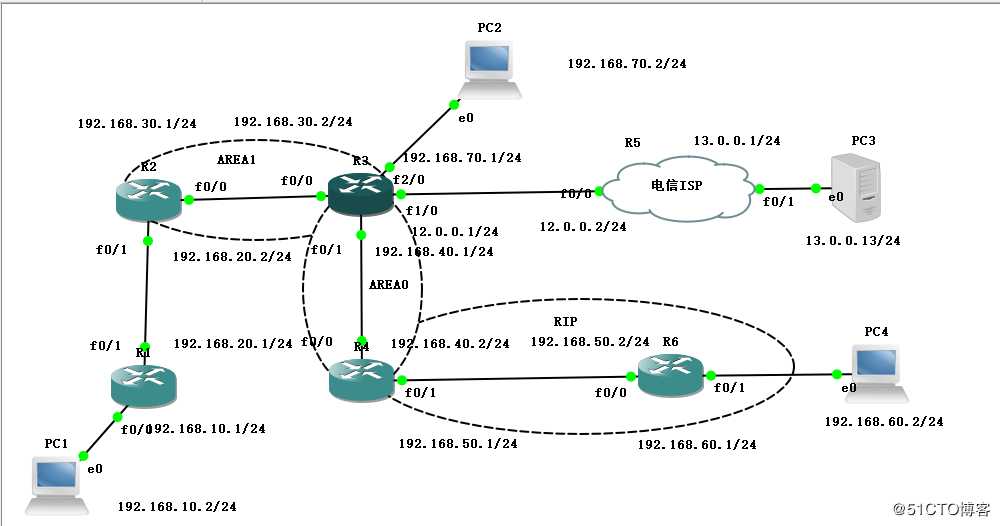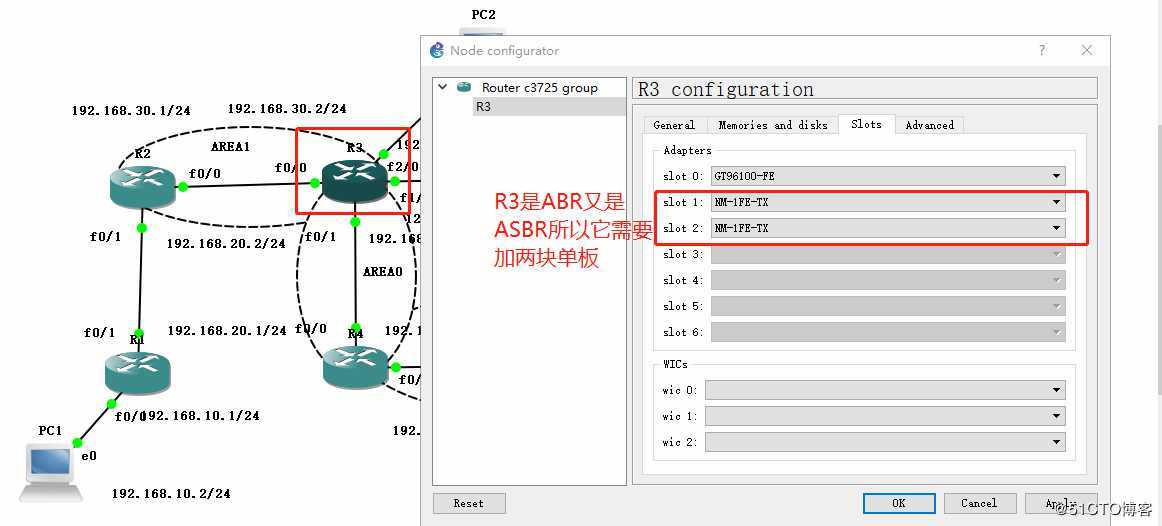路由器协议 ospf 静态 默认 rip 四大协议作用?
Posted
tags:
篇首语:本文由小常识网(cha138.com)小编为大家整理,主要介绍了路由器协议 ospf 静态 默认 rip 四大协议作用?相关的知识,希望对你有一定的参考价值。
知道这四大协议都是可以是路由器ping通………以使网络连通,请帮忙解释一下四大协议的区别……什么时候使用适合使用哪个协议……
静态路由:最为原始的配置路由方式,纯手工,易管理,但耗时、耗力,一般用于小型企业或者中等偏下型企业。默认路由:可以理解为静态路由的一种特殊形式,即排除现有的配置过的路由之后,剩下的流量走向均走默认路由。
RIP:距离矢量路由协议,中小型企业使用,但由于根据路由跳数来判断路由走向,不适合整体网络的规划和使用,且迄今已基本不使用。
OSPF:链路状态路由协议,中等至大型企业使用,根据链路状态数据库维护路由信息,整体性规划路由表及路由信息,现在普遍且流行使用。 参考技术A 静态路由,需要手工配置,决策快,适合小型网络。大型的网络手工配置能累死人。
OSPF,能自动决策,占用些许内存,适合大型网络,只需要几个命令就可以自动寻路。
默认路由,就是当匹配的路由条目进入这个默认路由时,统一全部往已经设置好的路线走。
Rip,和OSPF一样都是协议,占用内存,适合中小型网络,因为rip有跳数限制,只能16跳 参考技术B 更正这位回答中一个小小的错误,RIP以跳数为自己的度量值,最大为15跳,16跳为不可达。
网络必备——动态路由(默认路由+静态+OSPF+RIP综合实验)

本章目的:全网互通,R2设置静态路由,R2和R3在AREA1区域中使用OSPF协议 ,R3设置默认路由回来,R4和R5使用RIP协议
本章环境:GNS3,5台路由器,4台主机,1个外部网.
实验图:

- 路由器接口地址
R1:
f0/0(192.168.10.1/24)
f0/1(192.168.20.1/24)
R2:
f0/1(192.168.20.2/24)
f0/0(192.168.30.1/24)
R3:
f0/0(192.168.30.2/24)
f0/1(192.168.40.1/24)
f1/0(12.0.0.1/24)
f2/0(192.168.70.1/24)
R4:
f0/1(192.168.50.1/24)
f0/0(192.168.40.2/24)
R6:
f0/1(192.168.60.1/24)
f0/0(192.168.50.2/24)2.外部网地址:
R5:
f0/0(12.0.0.2/24)
f0/1(13.0.0.1/24)3.客户端地址:
PC机1:(192.168.10.2/24)
PC机2:(192.168.70.2/24)
PC机3:(13.0.0.13/24)
PC机4:(192.168.60.2/24)R3的路由器要多加一块单板

1.配置R1路由器
R1#conf t //进入全局模式
Enter configuration commands, one per line. End with CNTL/Z.
R1(config)#int f0/0 //进入接口
R1(config-if)#ip add 192.168.10.1 255.255.255.0 //设置地址
R1(config-if)#no shut //开启
R1(config-if)#ex
R1(config)#int f0/1
R1(config-if)#ip add 192.168.20.1 255.255.255.0
R1(config-if)#no shut
R1(config-if)#ex
R1(config)#do show ip route //查看路由表
Codes: C - connected, S - static, R - RIP, M - mobile, B - BGP
D - EIGRP, EX - EIGRP external, O - OSPF, IA - OSPF inter area
N1 - OSPF NSSA external type 1, N2 - OSPF NSSA external type 2
E1 - OSPF external type 1, E2 - OSPF external type 2
i - IS-IS, su - IS-IS summary, L1 - IS-IS level-1, L2 - IS-IS level-2
ia - IS-IS inter area, * - candidate default, U - per-user static route
o - ODR, P - periodic downloaded static route
Gateway of last resort is 192.168.20.2 to network 0.0.0.0
C 192.168.10.0/24 is directly connected, FastEthernet0/0 //直连网段
C 192.168.20.0/24 is directly connected, FastEthernet0/1 //直连网段
S* 0.0.0.0/0 [1/0] via 192.168.20.2 //默认网络2.配置R2路由器接口地址
R2#conf t
Enter configuration commands, one per line. End with CNTL/Z.
R2(config)#int f0/1
R2(config-if)#ip add 192.168.20.2 255.255.255.0
R2(config-if)#no shut
R2(config-if)#ex
R2(config)#int f0/0
R2(config-if)#ip add 192.168.30.1 255.255.255.0
R2(config-if)#no shut
R2(config-if)#ex3.配置R2静态路由和OSPF协议
R2(config)#router ospf 1 //进入OSPF协议1进程 在协议里一定要在同一个进程
R2(config-router)#router-id 2.2.2.2 //设置路由器router-id
R2(config-router)#network 192.168.30.0 0.0.0.255 area 1 //宣告30网段再骨干区域area1中
R2(config-router)#redistribute connected subnets //将R2直连的网段注入进来
R2(config-router)#redistribute static subnets //将 静态路由的10网段注入进来
R2(config-router)#ex
R2(config)#ip route 192.168.10.0 255.255.255.0 192.168.20.1 //设置静态路由 网段,子网掩码,下一跳地址
R2(config)#do show ip route
Codes: C - connected, S - static, R - RIP, M - mobile, B - BGP
D - EIGRP, EX - EIGRP external, O - OSPF, IA - OSPF inter area
N1 - OSPF NSSA external type 1, N2 - OSPF NSSA external type 2
E1 - OSPF external type 1, E2 - OSPF external type 2
i - IS-IS, su - IS-IS summary, L1 - IS-IS level-1, L2 - IS-IS level-2
ia - IS-IS inter area, * - candidate default, U - per-user static route
o - ODR, P - periodic downloaded static route
Gateway of last resort is not set
C 192.168.30.0/24 is directly connected, FastEthernet0/0
S 192.168.10.0/24 [1/0] via 192.168.20.1
C 192.168.20.0/24 is directly connected, FastEthernet0/14.配置R3接口地址
R3
R3#conf t
Enter configuration commands, one per line. End with CNTL/Z.
R3(config)#int f0/0
R3(config-if)#ip add 192.168.30.2 255.255.255.0
R3(config-if)#no shut
R3(config-if)#int f0/1
R3(config-if)#ip add 192.168.40.1 255.255.255.0
R3(config-if)#no shut
R3(config-if)#int f1/0
R3(config-if)#ip add 12.0.0.1 255.255.255.0
R3(config-if)#no shut
R3(config-if)#int f2/0
R3(config-if)#ip add 192.168.70.1 255.255.255.0
R3(config-if)#no shut
R3(config-if)#ex5.配置R3默认路由和OSPF协议
R3(config)#ip route 0.0.0.0 0.0.0.0 12.0.0.2 将R3设置成默认路由
R3(config)#router ospf 1 //开启OSPF进程1
R3(config-router)#router-id 3.3.3.3 //设置路由router-id
R3(config-router)#network 192.168.30.0 0.0.0.255 area 1 宣告30网段在area 1区域中
R3(config-router)#network 192.168.40.0 0.0.0.255 area 0 宣告40网段在area 0区域中
R3(config-router)#network 192.168.70.0 0.0.0.255 area 0宣告70网段在area 0区域中
R3(config-router)#ex
R3(config)#do show ip route
Codes: C - connected, S - static, R - RIP, M - mobile, B - BGP
D - EIGRP, EX - EIGRP external, O - OSPF, IA - OSPF inter area
N1 - OSPF NSSA external type 1, N2 - OSPF NSSA external type 2
E1 - OSPF external type 1, E2 - OSPF external type 2
i - IS-IS, su - IS-IS summary, L1 - IS-IS level-1, L2 - IS-IS level-2
ia - IS-IS inter area, * - candidate default, U - per-user static route
o - ODR, P - periodic downloaded static route
Gateway of last resort is 12.0.0.2 to network 0.0.0.0
C 192.168.30.0/24 is directly connected, FastEthernet0/0
O E2 192.168.10.0/24 [110/20] via 192.168.30.1, 00:00:49, FastEthernet0/0
C 192.168.40.0/24 is directly connected, FastEthernet0/1
O E2 192.168.20.0/24 [110/20] via 192.168.30.1, 00:00:49, FastEthernet0/0
12.0.0.0/24 is subnetted, 1 subnets
C 12.0.0.0 is directly connected, FastEthernet1/0
C 192.168.70.0/24 is directly connected, FastEthernet2/0
S* 0.0.0.0/0 [1/0] via 12.0.0.26.配置R4接口地址
R4#conf t
Enter configuration commands, one per line. End with CNTL/Z.
R4(config)#int f0/0
R4(config-if)#ip add 192.168.40.2 255.255.255.0
R4(config-if)#no shut
R4(config-if)#int f0/1
R4(config-if)#ip add 192.168.50.1 255.255.255.0
R4(config-if)#no shut
R4(config-if)#ex7.配置R4RIP协议,注入OSPF协议
R4(config)#router rip //进入rip协议
R4(config-router)#ver 2 //使用2版本协议
R4(config-router)#no auto-summary //关闭路由汇总
R4(config-router)#network 192.168.50.0 //宣告网段
R4(config-router)#redistribute ospf 1 metric 5 //在rip协议中注入OSPF协议
R4(config-router)#router ospf 1 //开启OSPF进程1
R4(config-router)#router-id 4.4.4.4
R4(config-router)#network 192.168.40.0 0.0.0.255 area 0
R4(config-router)#redistribute rip subnets
R4(config-router)#ex
R4(config)#do show ip route
Codes: C - connected, S - static, R - RIP, M - mobile, B - BGP
D - EIGRP, EX - EIGRP external, O - OSPF, IA - OSPF inter area
N1 - OSPF NSSA external type 1, N2 - OSPF NSSA external type 2
E1 - OSPF external type 1, E2 - OSPF external type 2
i - IS-IS, su - IS-IS summary, L1 - IS-IS level-1, L2 - IS-IS level-2
ia - IS-IS inter area, * - candidate default, U - per-user static route
o - ODR, P - periodic downloaded static route
Gateway of last resort is 192.168.40.1 to network 0.0.0.0
O IA 192.168.30.0/24 [110/20] via 192.168.40.1, 00:00:18, FastEthernet0/0
O E2 192.168.10.0/24 [110/20] via 192.168.40.1, 00:00:18, FastEthernet0/0
C 192.168.40.0/24 is directly connected, FastEthernet0/0
O E2 192.168.20.0/24 [110/20] via 192.168.40.1, 00:00:18, FastEthernet0/0
C 192.168.50.0/24 is directly connected, FastEthernet0/1
O 192.168.70.0/24 [110/11] via 192.168.40.1, 00:00:18, FastEthernet0/0
O*E2 0.0.0.0/0 [110/1] via 192.168.40.1, 00:00:18, FastEthernet0/08.配置R6接口地址
R6#conf t
Enter configuration commands, one per line. End with CNTL/Z.
R6(config)#int f0/0
R6(config-if)#ip add 192.168.50.2 255.255.255.0
R6(config-if)#no shut
R6(config-if)#int f0/1
R6(config-if)#ip add 192.168.60.1 255.255.255.0
R6(config-if)#no shut
R6(config-if)#ex9.配置R6RIP协议
R6(config)#router rip
R6(config-router)#ver 2
R6(config-router)#no auto-summary
R6(config-router)#network 192.168.50.0
R6(config-router)#network 192.168.60.0
R6(config-router)#ex
R6(config)#do show ip route
Codes: C - connected, S - static, R - RIP, M - mobile, B - BGP
D - EIGRP, EX - EIGRP external, O - OSPF, IA - OSPF inter area
N1 - OSPF NSSA external type 1, N2 - OSPF NSSA external type 2
E1 - OSPF external type 1, E2 - OSPF external type 2
i - IS-IS, su - IS-IS summary, L1 - IS-IS level-1, L2 - IS-IS level-2
ia - IS-IS inter area, * - candidate default, U - per-user static route
o - ODR, P - periodic downloaded static route
Gateway of last resort is 192.168.50.1 to network 0.0.0.0
R 192.168.30.0/24 [120/5] via 192.168.50.1, 00:00:21, FastEthernet0/0
C 192.168.60.0/24 is directly connected, FastEthernet0/1
R 192.168.10.0/24 [120/5] via 192.168.50.1, 00:00:21, FastEthernet0/0
R 192.168.40.0/24 [120/5] via 192.168.50.1, 00:00:21, FastEthernet0/0
R 192.168.20.0/24 [120/5] via 192.168.50.1, 00:00:21, FastEthernet0/0
C 192.168.50.0/24 is directly connected, FastEthernet0/0
R 192.168.70.0/24 [120/5] via 192.168.50.1, 00:00:21, FastEthernet0/0
R* 0.0.0.0/0 [120/1] via 192.168.50.1, 00:00:22, FastEthernet0/010.配置R5外部网默认路由,和接口地址
R5R5#conf t
Enter configuration commands, one per line. End with CNTL/Z.
R5(config)#ip route 192.168.0.0 255.255.0.0 12.0.0.1 //设置成默认路由
R5(config)#int f0/0
R5(config-if)#ip add 12.0.0.2 255.255.255.0
R5(config-if)#no shut
R5(config-if)#int f0/1
R5(config-if)#ip add 13.0.0.1 255.255.255.0
R5(config-if)#no shut
R5(config-if)#ex
R5(config)#do show ip route
Codes: C - connected, S - static, R - RIP, M - mobile, B - BGP
D - EIGRP, EX - EIGRP external, O - OSPF, IA - OSPF inter area
N1 - OSPF NSSA external type 1, N2 - OSPF NSSA external type 2
E1 - OSPF external type 1, E2 - OSPF external type 2
i - IS-IS, su - IS-IS summary, L1 - IS-IS level-1, L2 - IS-IS level-2
ia - IS-IS inter area, * - candidate default, U - per-user static route
o - ODR, P - periodic downloaded static route
Gateway of last resort is not set
12.0.0.0/24 is subnetted, 1 subnets
C 12.0.0.0 is directly connected, FastEthernet0/0
13.0.0.0/24 is subnetted, 1 subnets
C 13.0.0.0 is directly connected, FastEthernet0/1
S 192.168.0.0/16 [1/0] via 12.0.0.111.给四台主机配好地址
PC1> ip 192.168.10.2 192.168.10.1
Checking for duplicate address...
PC1 : 192.168.10.2 255.255.255.0 gateway 192.168.10.1
PC2> ip 192.168.70.2 192.168.70.1
Checking for duplicate address...
PC1 : 192.168.70.2 255.255.255.0 gateway 192.168.70.1
PC3> ip 13.0.0.13 13.0.0.1
Checking for duplicate address...
PC1 : 13.0.0.13 255.255.255.0 gateway 13.0.0.1
PC号主机> ip 192.168.60.2 192.168.60.1
Checking for duplicate address...
PC1 : 192.168.60.2 255.255.255.0 gateway 192.168.60.112.验证一下是不是全网互通
PC1> ping 192.168.70.2
192.168.70.2 icmp_seq=1 timeout
192.168.70.2 icmp_seq=2 timeout
84 bytes from 192.168.70.2 icmp_seq=3 ttl=61 time=62.159 ms
84 bytes from 192.168.70.2 icmp_seq=4 ttl=61 time=62.159 ms
84 bytes from 192.168.70.2 icmp_seq=5 ttl=61 time=66.171 ms
PC1> ping 13.0.0.13
13.0.0.13 icmp_seq=1 timeout
13.0.0.13 icmp_seq=2 timeout
84 bytes from 13.0.0.13 icmp_seq=3 ttl=60 time=92.298 ms
84 bytes from 13.0.0.13 icmp_seq=4 ttl=60 time=92.248 ms
84 bytes from 13.0.0.13 icmp_seq=5 ttl=60 time=94.935 ms
PC1> ping 192.168.60.2
192.168.60.2 icmp_seq=1 timeout
84 bytes from 192.168.60.2 icmp_seq=2 ttl=59 time=112.913 ms
84 bytes from 192.168.60.2 icmp_seq=3 ttl=59 time=110.144 ms
84 bytes from 192.168.60.2 icmp_seq=4 ttl=59 time=116.545 ms
84 bytes from 192.168.60.2 icmp_seq=5 ttl=59 time=116.432 ms以上就是我们的综合实验了,下一章OSPF最后一个实验虚链路。
以上是关于路由器协议 ospf 静态 默认 rip 四大协议作用?的主要内容,如果未能解决你的问题,请参考以下文章
GNS3路由配置综合实验(OSPF协议RIP协议静态路由默认路由)
网络必备——动态路由(默认路由+静态+OSPF+RIP综合实验)